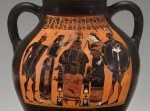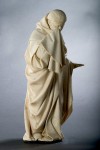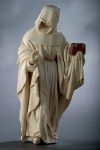The elaborate tombs of the dukes of Burgundy are among the masterpieces of late medieval sculpture in Europe. The Mourners: Tomb Sculptures from the Court of Burgundy presents thirty-seven alabaster mourners, considered embodiments of late medieval devotion and piety. They convey powerful emotion, some lost in thought or giving vent to their grief, and others consoling their neighbors. Mourning, they remind us, is a collective experience, common to all people and all moments in history.
The Dukes of Burgundy were the wealthiest and most powerful aristocrats in northern Europe and oversaw a magnificent court. Although artists in every medium worked for them, it was the achievement of their sculptors in the 14th century that produced the most profound and original art. From the studio of the great Claus Sluter emerged sculpture that rivaled – some argue surpassed – anything done in Italy at the time. The summit of their achievement were the tombs of the Burgundian Dukes.
The elaborate tombs of the first Valois dukes of Burgundy, Philip the Bold and his son, John the Fearless, are among the masterpieces of late medieval sculpture in Europe. These monuments feature the sculpted figures of the deceased rulers lying in state atop the tombs, while below a procession of mourning figures appears to slip in and out of the arcades of a cloister. The mourners are intended to evoke the funeral processions of the dukes, events that brought together various elements of Burgundian society: nobility, clergy, and laypersons. They convey powerful emotion, some lost in thought or giving vent to their grief, and others consoling their neighbors. Mourning, they remind us, is a collective experience, common to all people and all moments in history.
The tombs were originally installed in a monastery outside Dijon, but since the early nineteenth century they have been on display in the Musée des Beaux-Arts of Dijon. Renovations of the museum’s medieval galleries have created the occasion for American audiences to discover for themselves these celebrated sculptures. The Mourners: Tomb Sculptures from the Court of Burgundy at VMFA features thirty-seven mourners from the tomb of John the Fearless, second duke of Burgundy, displayed independently of the tomb’s architectural framework – offering a unique opportunity to appreciate these sculptures for their precise naturalism, variety, and profoundly moving character.
For more information, including 3-D views of each sculpture, please visit mourners.org.
VMFA is the final venue in the United States, and when the sculptures return to the Musée des Beaux-arts de Dijon in 2012, they will be permanently repositioned in the tomb setting.
The Mourners: Medieval Tomb Sculptures from the Court of Burgundy has been organized by the Dallas Museum of Art and the Musée des Beaux Arts de Dijon, under the auspices of FRAME (French Regional and American Museum Exchange). The exhibition is supported by a leadership gift from the Iris and B. Gerald Cantor Foundation. Additional support is provided by the Florence Gould Foundation, the Eugene McDermott Foundation, Connie Goodyear Baron and Boucheron. Major corporate support is provided by Bank of the West – Member BNP Paribas Group. The exhibition is supported by an indemnity from the Federal Council on the Arts and Humanities.
Event Has Concluded
Ancient Art Collection Fact Sheet
Posted on March 3, 2010
Collection includes objects from Egyptian, Near Eastern, Aegean, Greek, Etruscan, Roman and Byzantine cultures Read more





